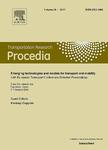版权所有:内蒙古大学图书馆 技术提供:维普资讯• 智图
内蒙古自治区呼和浩特市赛罕区大学西街235号 邮编: 010021

作者机构:Graz University of Technology Institute of Highway Engineering and Transport Planning Rechbauerstraße 12 8010 Graz Austria SLR Engineering GmbH Gartengasse 19 8010 Graz Austria
出 版 物:《Transportation Research Procedia》
年 卷 期:2019年第37卷
页 面:330-337页
主 题:Traffic state detection Traffic prediction Cluster time series analysis Optimization algorithm Traffic flow modeling
摘 要:This study proposes a model for predicting traffic flow and an algorithm to optimize lane allocation in front of an Austrian toll plaza. The traffic prediction model uses local traffic data from the motorway and is based on time series analysis. The prediction is structured into three levels: trend prediction for all calendar days in the year, long-term prediction for the current day and short-term prediction for the next hour. The error of long-term prediction was less than 15% per hour over the whole day. An optimization algorithm for better lane allocation was developed by using a camera based traffic state detection system at the toll plaza. Based on the measured queue lengths per toll gate lane, the algorithm shifts vehicles to lower queued areas in front of the toll plaza. Therefore, the algorithm was able to reduce travel times up to 6% in daily average and queue lengths with more than 100m up to 30% per lane. The prediction model and optimization algorithm are not site-specific and can also be applied on different toll plazas or bottlenecks on motorways (e.g. road works, border crossing, motorway junction etc.).